Edible mushrooms are one of the most exciting things to learn how to forage, but it can be an intimidating and sometimes dangerous practice. These easy-to-identify edible mushrooms are a safe place to start your wild mushroom journey!
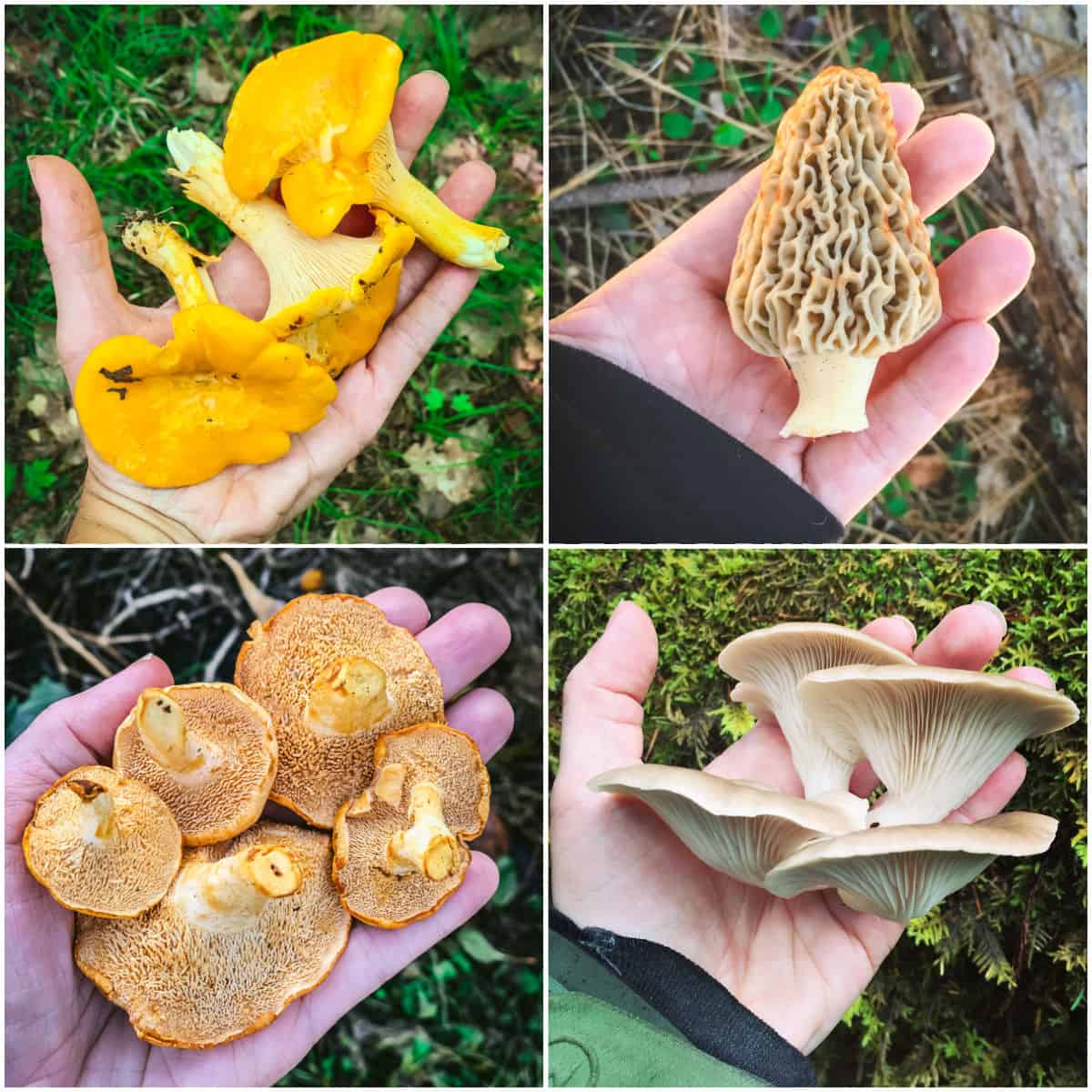
Want to save this post for later?
Wildcrafting Weeds
If you want to learn more about the edible and medicinal weeds that surround us and how to use them, check out my eBook: Wildcrafting Weeds: 20 Easy to Forage Edible and Medicinal Plants (that might be growing in your backyard)!
Mushroom Hunting for Beginners
Mushroom hunting can be a bit scary, especially if you’re a beginner. That doesn’t mean that you shouldn’t do it, though. Everyone has to start somewhere!
You can learn how to identify and forage for wild edible mushrooms, even if you are a beginning mushroom hunter. Finding mushrooms in the forest is mysterious and satisfying.
I advise beginners to start mushroom foraging by simply paying attention. Observe different mushrooms that you may see, and consult a guidebook as you go along.
Don’t pick or eat any mushroom you find until you verify what the mushroom is with an experienced hunter, even if you think you know what it is.
I recommend starting with these eight varieties of edible mushrooms: oysters, morels, lobster, chanterelles, lion’s mane, chicken of the woods, hedgehog, and giant puffballs.
I chose these eight because they are some of the easiest to identify once you know what to look for, are somewhat common, and are super tasty!
But First! Get a Mushroom Guidebook
The first thing anyone interested in mushroom foraging should do is buy a mushroom identification guidebook.
Two of my favorites are All That the Rain Promises and More by David Arora and Mushrooms of the Northeast by Teresa Marrone and Walt Sturgeon. They both have good pictures and great descriptions while still being small enough to carry on the trail easily.
This Field Guide to North American Mushrooms from the National Audubon Society looks like another great option, too.
Related: 12 Best Books on Foraging and Wildcrafting
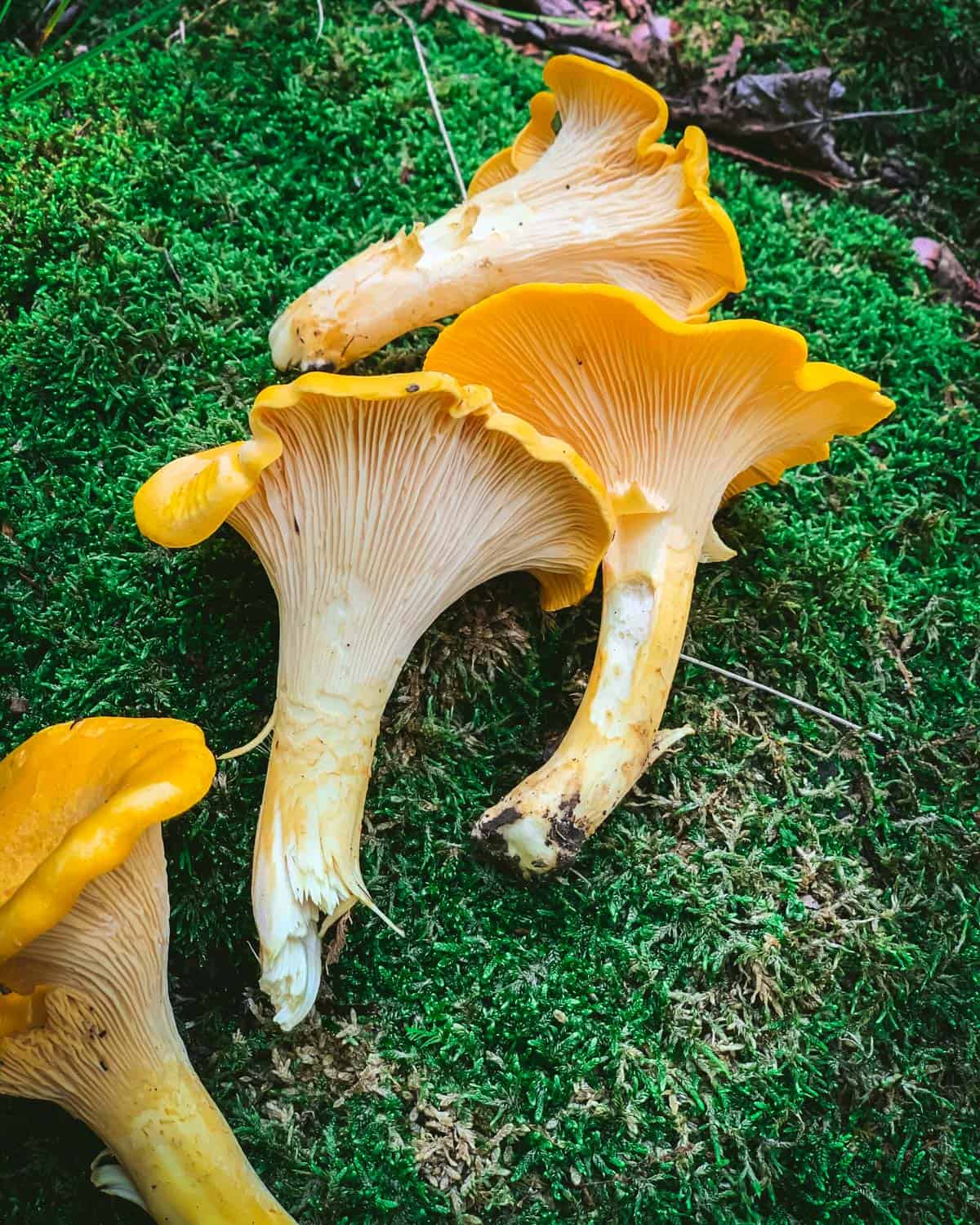
Easy to Identify Edible Mushrooms
Before we get into the eight easy to identify edible mushrooms list, I want to clarify something everyone should always remember: mushrooms with gills are tricky. Don’t skip this part.
Mushrooms with Gills are Tricky
Seven out of eight of these mushrooms do not have regular gills. Only one does have regular gills.
Mushrooms with gills can be very hard to distinguish from one another, and several of them are poisonous.
In fact, the death cap and destroying angel can kill you with just a couple of bites!
It’s much better to be safe than sorry.
Oyster mushrooms are the only ones in this group that do have regular gills, and I explain what makes them different below.
Oyster Mushrooms
As I mentioned, oyster mushrooms are the only mushrooms with gills that I recommend anyone to forage, unless you are a highly skilled mycologist.
This is because oyster mushrooms almost always grow on dead wood, such as trees, stumps, or downed logs.
While they sometimes appear to be growing out of the ground from wood chips or other substrate, I would not trust that they are oysters unless you find them on wood.
Oyster mushrooms grow in shelf like clusters, usually on hardwoods, but sometimes on conifers.
They generally like cooler weather, so spring and fall are the best times to find them. They are quite common, and very tasty!
Read more about oysters in my post Foraging for Oyster Mushrooms.
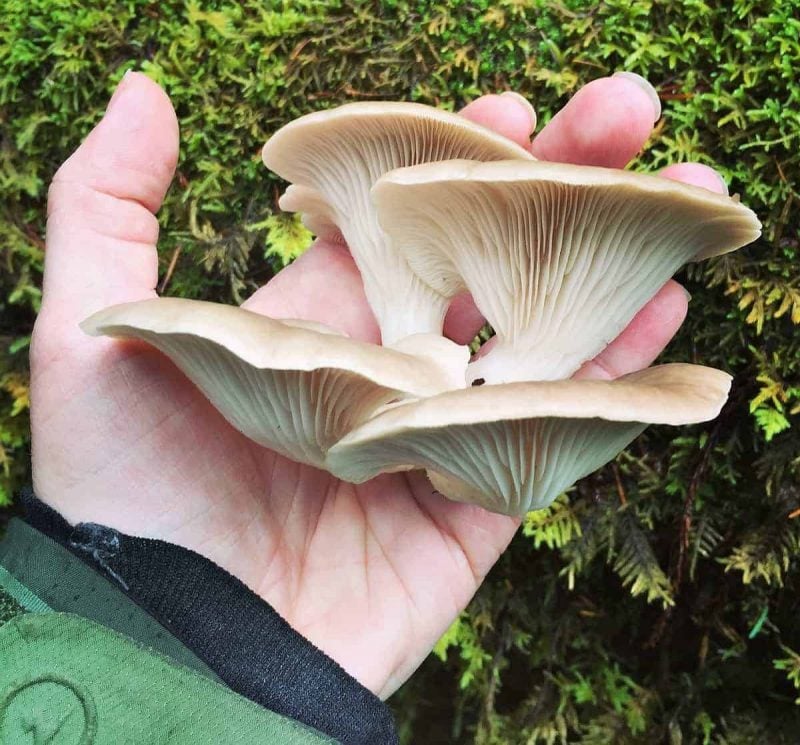
Morel Mushrooms
Morel mushrooms are the darling of many edible mushroom hunters, and for good reason! They are fun to forage for, and for some reason when they are found the excitement is huge!
Maybe it’s because they pop up in the springtime and we are all yearning for wild mushrooms by then. Or, it could be that they seem elusive in hiding, and can’t be easily cultivated.
The only way to get these mushrooms is in the great outdoors. Morels like south-facing hillsides and are typically found in sunny patches. They also commonly come up in areas that have been recently burned.
They are one of the easier mushrooms to identify, as nothing looks quite like them.
Morel mushrooms have a pitted and deeply ridged, honeycomb like cap, and are completely hollow when cut in half.
Morel mushrooms need to be cooked before eaten.
There are some mushrooms that are called “false morels” because they are somewhat similar in resemblance, but they are not hollow. They are not so toxic that they can kill you with only a few bites, but they can definitely cause a lot of gastric distress.
Read more about morels in my post Foraging for Morel Mushrooms.
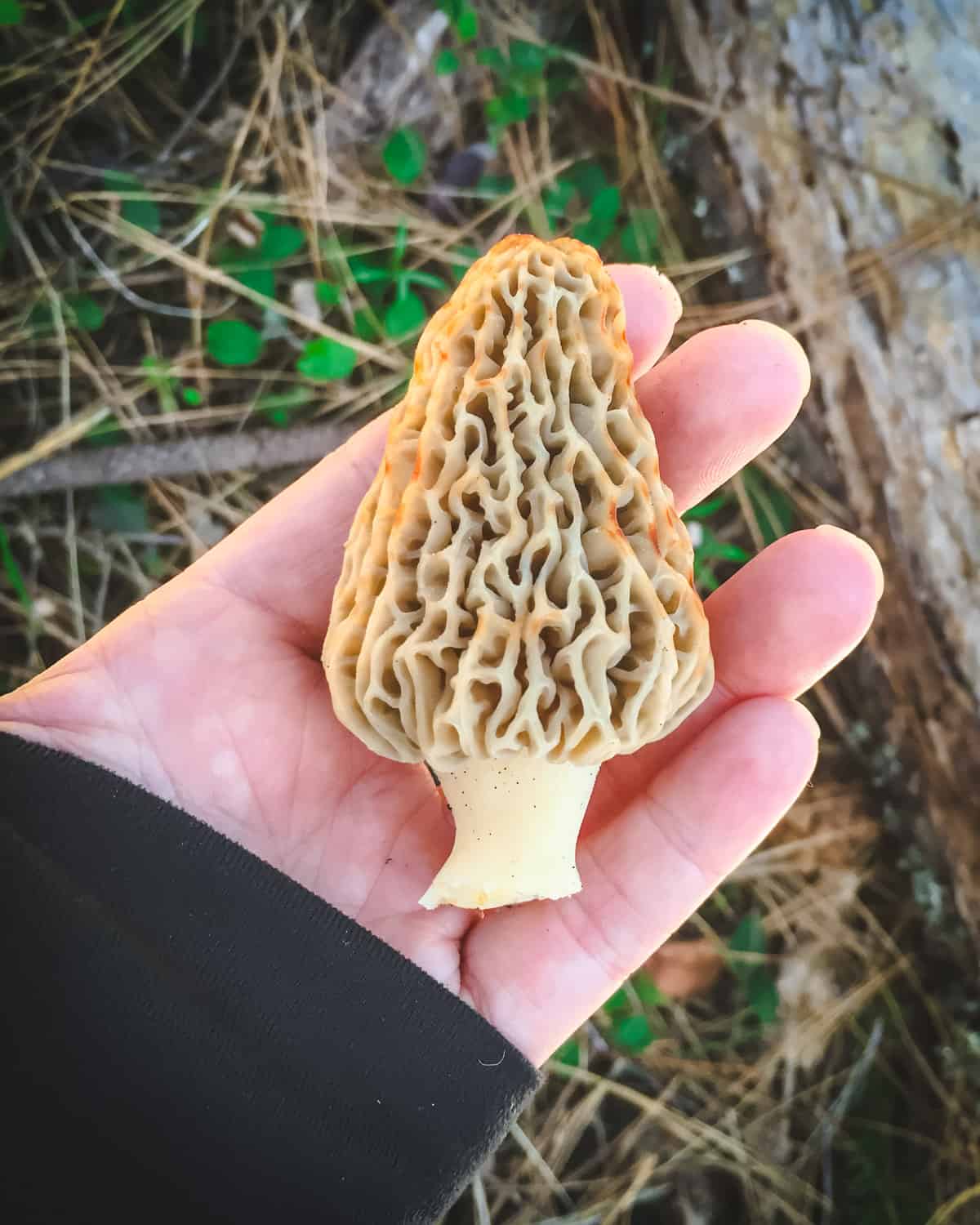
Hedgehog Mushrooms
Hedgehog mushrooms are fun to find, and they go by several names, such as Sweet Tooth, Hedgies, Belly Buttons, and Sheep’s Foot.
Hedgehogs (Hydnum sp.) hold all of their nicknames for good reason. Their surface is spiky like a hedgehog, they taste sweet, and their irregular shape leads to belly buttons and sheep’s feet.
These mushrooms are common and are easily found across the United States and worldwide. They are easy to identify and have a sweet and mild taste similar to chanterelles.
The hedgehog mushroom has a spherical cap with a dent on one side, which gives it the name sheep’s foot. As the mushroom ages, however, the dent smooths out.
They are usually light in color, a yellowish peach. Depending on the species and location, they can range to a darker color, almost brown.
Most distinctively is the hedgehog-like spines that grow on the underside of the cap. The spines, or “teeth,” can grow to be about a quarter inch, have a pale color, and can be easily removed by the force of a finger.
Hedgehogs are found in forests and always grow at the roots of trees in a symbiotic relationship. Some examples of the roots where you might find them are oak, beech, pine, spruce, and Douglas fir.
This list is not extensive as these mushrooms have a wide variety of hosts, but learning to identify the trees in your area can also be helpful.
There are at least 49 different species of hedgehog mushrooms! They all look similar, are easily identified as such, and are edible.
Otherwise, there is no close look like these tasty edible mushrooms, which makes them perfect for beginning mushroom foragers.
Read more about Foraging Hedgehog Mushrooms.
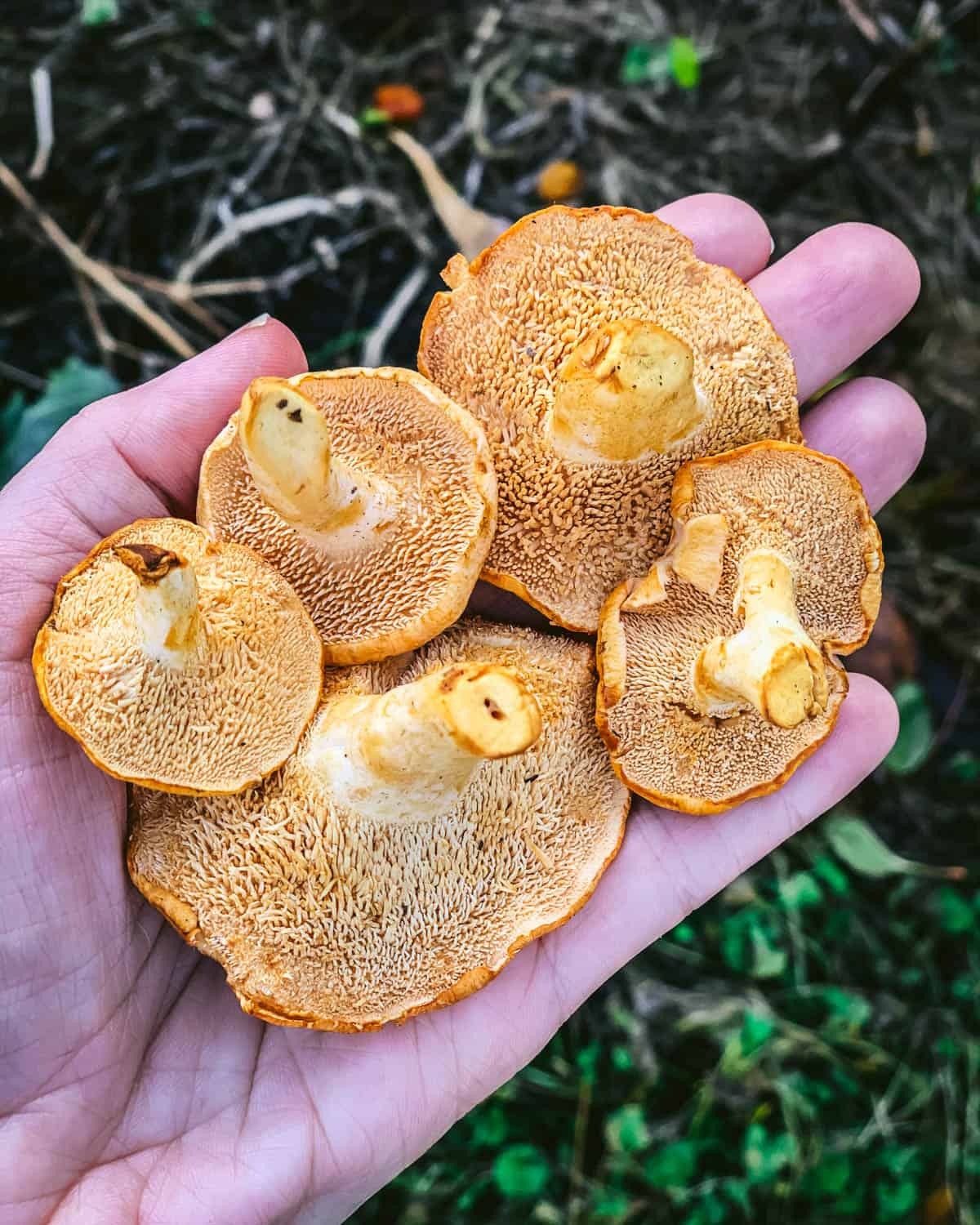
Lobster Mushrooms
Lobster mushrooms are cool because they actually aren’t mushrooms at all. Instead, they are a fungus that grows on certain species of mushrooms, engulfing its host.
They are especially common in the Pacific Northwest, and they are quite unmistakable once found!
Lobster mushrooms have a hard red to orange exterior and a white interior, thus resembling a lobster.
The best part about lobster mushrooms is that there are no poisonous look-alikes at all!
Read more about lobsters in my post Foraging for Lobster Mushrooms.
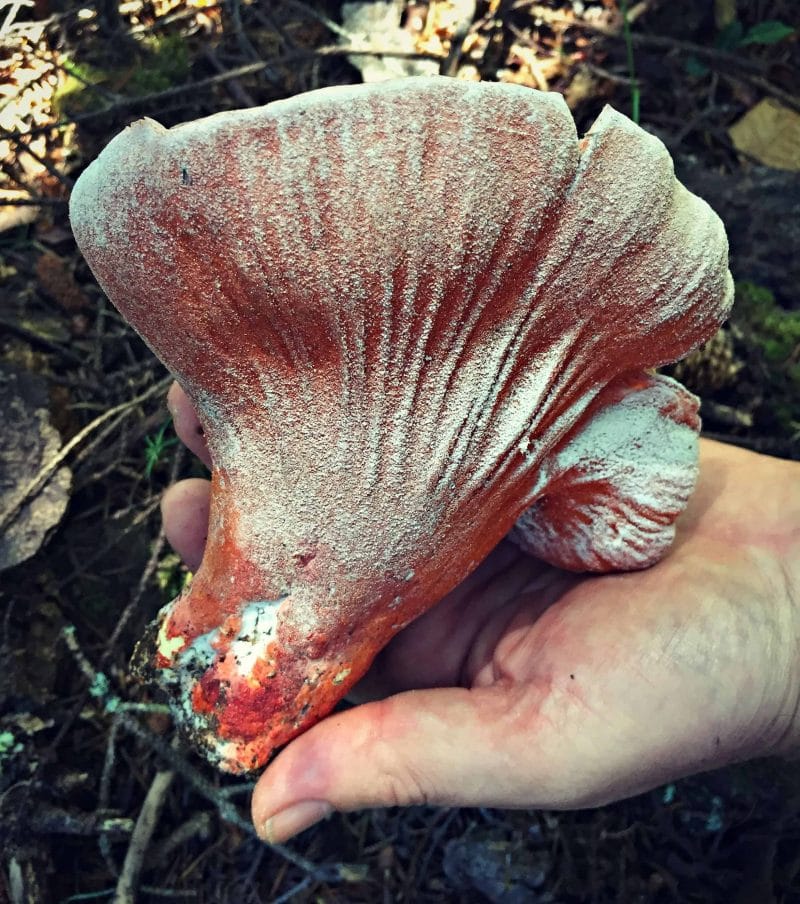
Chanterelle Mushrooms
Chanterelle mushrooms are perhaps my favorite mushrooms to forage. While finding any wild edible mushroom is exciting, I get an extra little charge from chanterelles. They are beautiful and delectable!
They are typically found in the fall after the first rains. But in some areas with higher humidity, they can be found throughout the summer.
Chanterelle mushrooms are yellow to orange in color, and have blunt ridges that fork and run down the stem rather than true gills.
The stems are solid, the flesh is white, and they have a fruity aroma.
There is another variety of chanterelles that are similar in appearance, but have hollow stems. They are called winter or yellowfoot chanterelles.
There are two possible chanterelle look-a-likes that are poisonous: the jack-o’-lantern and false chanterelle.
Both of these have true gills rather than blunt ridges, so that is key to properly distinguishing a true chanterelle.
Read more about chanterelles in my post Foraging for Chanterelle Mushrooms.
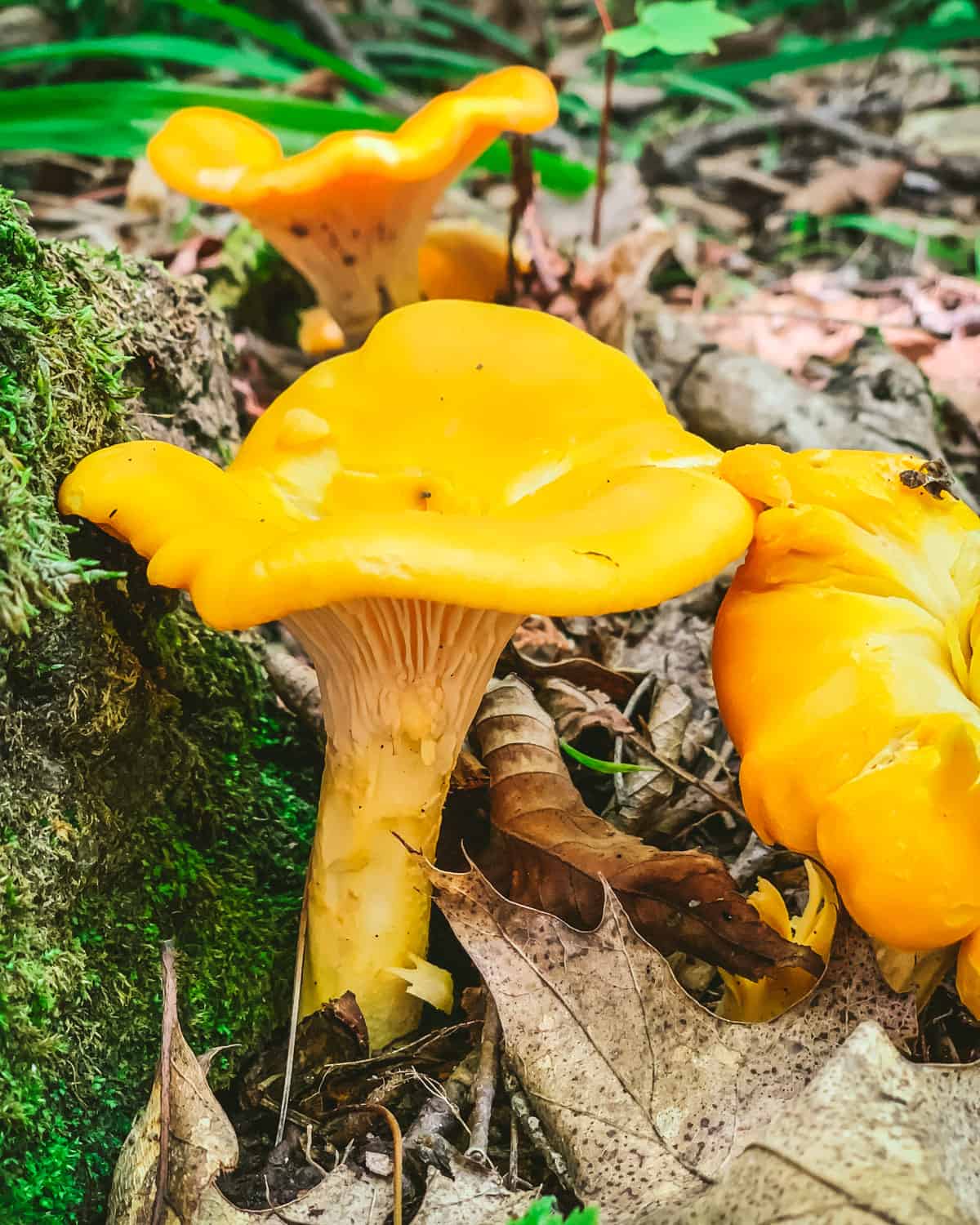
Chicken of the Woods Mushrooms
Chicken of the woods mushrooms (laetiporus sp.) are common, easy to find and identify, and grow primarily in the summertime. Some regions will see them in late spring to early autumn depending on the climate.
These delicious edible mushrooms are decomposing, meaning they’ll be found on dying or dead wood. Their yellow-orange hue makes them easy to spot on a tree’s bark.
They grow in clusters in a horizontal “shelf” pattern. The underside is usually bright yellow, and it has a thicker ridge on the outside edges.
Chicken of the Woods has a unique look, and there really are no other mushrooms that it can reasonably be mistaken for. These edible mushrooms taste, you guessed it, like chicken! They cook up nicely as a substitute for fried chicken.
Read more about Foraging Chicken of the Woods.

Lion’s Mane Mushrooms
Lion’s mane mushrooms (Hericium erinaceus) have a distinct look that makes them super easy to identify with a whimsical cartoon look featuring long white spines.
Not to be confused with a hedgehog mushroom, when a lion’s mane is young with short spines, they are sometimes called a faceless hedgehog.
Lion’s mane and other Hericium species share a common feature: they all are white or light in color with dangling “teeth” of varying lengths, depending on the species.
Lion’s mane is a single ball or clump with no branching. It has dangling teeth that can grow to be 2 inches long or more and look like a big pom pom with a ball-like shape.
They can be small to very large, even up to one foot across!
They are a fall-season mushroom that grows on dead or dying oak, beech, or maple trees. The only exception is the subspecies that grows in the west of the US, which primarily grows on conifers.
There are many subspecies of Hericium, and they are all edible mushrooms that look similar, so there isn’t much risk of mistakes or look-a-likes when foraging for lion’s mane.
Read more about lion’s mane in my post Foraging Lion’s Mane Mushrooms.
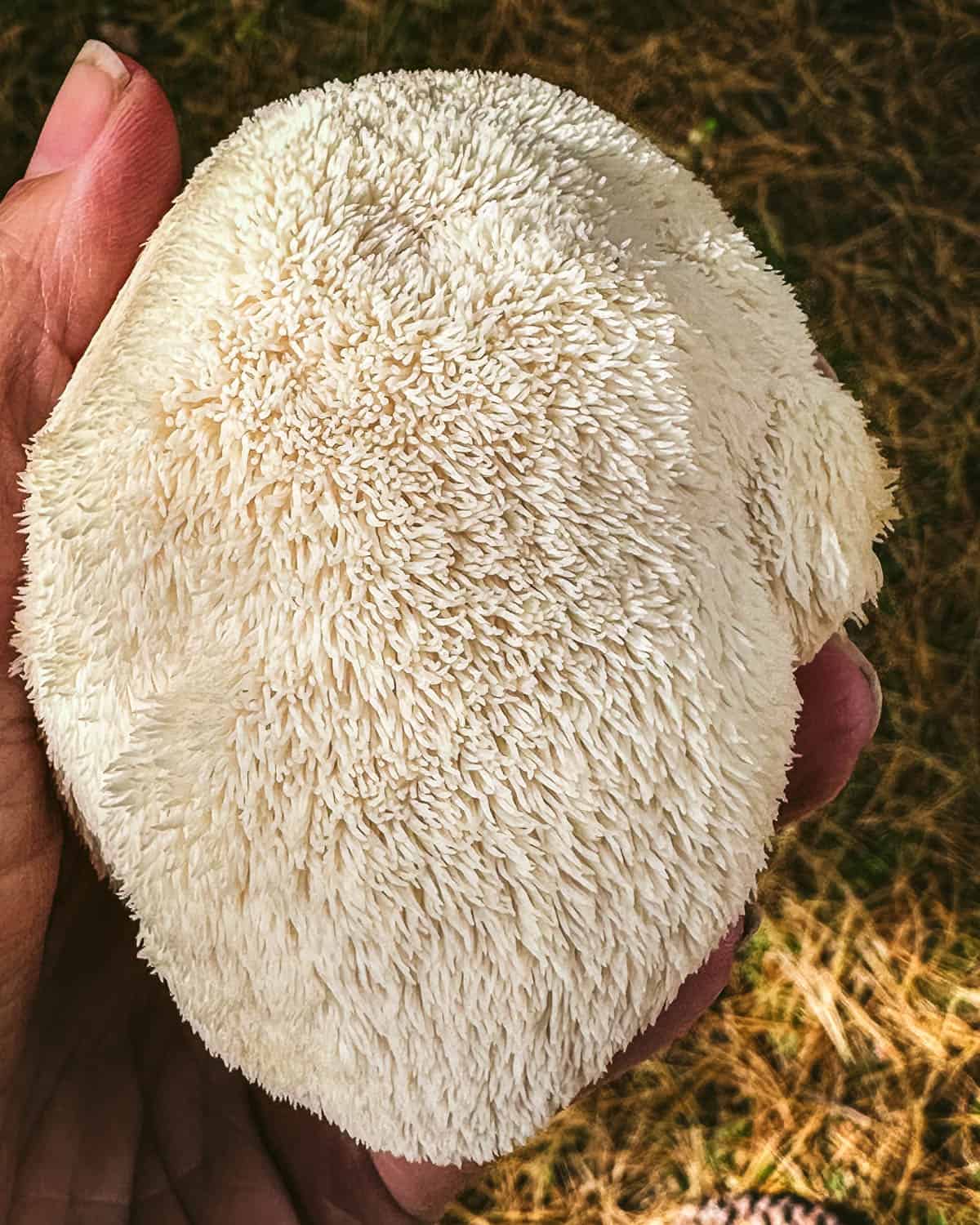
Giant Puffball Mushroom
Giant puffball mushrooms are one of the easiest edible mushrooms to identify, and based on their size are easy to spot if you’ve got some in your area.
Several species of mushrooms resemble small puffball mushrooms, and some are toxic. However, once you cut them open, you will know which is which.
An edible puffball will be bright white inside, with no trace of gills. Since some puffball mushrooms are also toxic, these two features must be present together to identify them as edible puffballs.
If the puffball’s interior is white but has gills, it’s toxic. If it’s black, it will be toxic. However, if it’s yellow or green, it’s past its edible phase and is ready to do its magical poof of dusty-like pores spreading when popped open.
A giant puffball mushroom looks exactly like it sounds: a big orb-shaped mushroom that is white on the outside. If you’ve found the edible type, it will be white on the inside, too.
Read more about giant puffball mushrooms in Foraging Puffball Mushrooms.
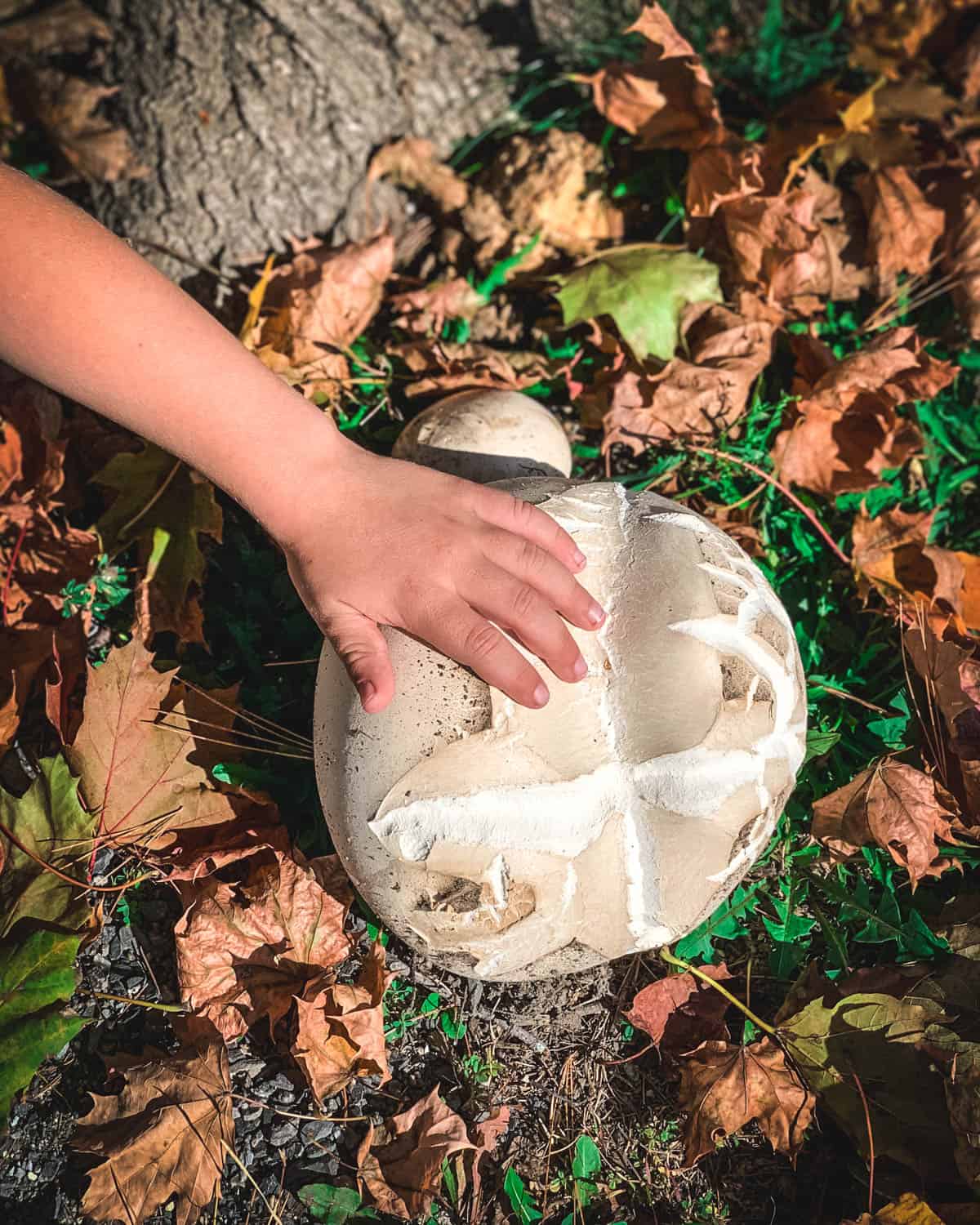
Well, there you have it! Eight easy to identify edible mushrooms, perfect for the beginning mushroom forager.
Note: Please consult your guidebooks, go with an experienced mushroom hunter, and start foraging!
More Mushroom Love
- Mushroom Chocolates with Adaptogens
- Candy Cap Mushroom Cookies
- Reishi and Lion’s Mane Mushroom Hot Chocolate
- Best Mushroom Books for Kids
- Reishi Mushroom Infused Red Wine
- 6 Medicinal Mushrooms for Your Health
- Foraging Shaggy Mane Mushrooms

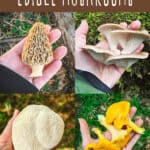
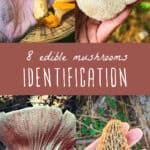

Having some photos of the look-alikes would have been very helpful. Especially when they are potentially dangerous.
None of the edible mushrooms on this list have dangerous look-alikes, which is why I only provide a link to them.
Jack o lanterns is very look alike to chanterelles
Can you do a post on mushrooms in Arkansas? I am stuck here and am never able to identify edibles other than the basics. P.S. there is a golden gill bolete here and it is very tasty! ;}
Hi Camilla. I’m sorry, I don’t live near Arkansas or know what kind of mushrooms grow there. I would try to find a mushroom foraging book that covers your region.
if you’ve had a horrible fire and it’s wiped out everything do the Boletes ,Chanterelles, Oysters, and Lobsters, come back and if so how long does it take. I live in Northern California by the Oregon border.
Hi Lannie. Morels are the only mushroom I know of that pop up in fire-scorched areas. Chanterelles and oysters do tend to come back year after year in the same places. Whether or not their occurrence is more prevalent due to fire, isn’t known.
This is not appropriate for European readers because the common names are different.
I enjoyed this article and am familiar with 4 of the ones you picked, was just curious tho as the bolete and lobster could be confusing to an amateur whereas I’ve found two very easily identifiable ones are coral and lions mane which both have no poisonous relatives and might be easier to find
I was confused for a moment when you said that the only poisonous boletes were the ones that bruise blue and/or have the red tinge or bleed red, then I realized I was thinking of milk caps, where those characteristics are of an edible species. I love your website! It’s so information-packed, aesthetically pleasing, exciting, inspiring, and more!
Thank you so much! I’m so glad you’re enjoying being here!
We have a ton of mushrooms in our back yard wooded area but it’s so hard to tell if they are edible or not. Could you help me?!?!
I’m sorry. It’s really difficult to identify mushrooms with only images alone. I suggest you check out a mushroom field guide like All That the Rain Promises and More.
I have found a mushroom and when I had looked it was it showed me it was a chicken mushroom. Have you ever hear of this kind? I have a picture if you can check it out. Love your site. Very educational.
Thank you! Is your mushroom called chicken of the woods?
This is a good read. Thanks for educating us on different types of mushrooms. There are a lot available with different characteristics. Mushrooms are indeed magical, it has endless capabilities. Keep posting!
Thank you!
I’d be more comfortable if you rephrased “The toxic varieties will turn blue when cut or bruised”, as Some toxic varieties… As there are toxic boletes which are not blue-staining, and this could make for a dangerous rule-of-thumb for the inexperienced.
Hello all,We live on the east coast in New Jersey and have several acres of woods. Can anyone tell us what species of edible mushrooms,if any grow or are native to our area? Many thanks to Colleen and all for their help.
Check out this youtube channel. It is great for finding NE USA mushrooms: Learn Your Land: https://www.youtube.com/channel/UCcbf8wnyVJl631LAmAbo7nw
When in doubt send me your morels, I will dispose of any deemed “dangerous” for you. This is a free service.
there are mushroom identifying groups on facebook. they will ask for pictures top to bottom and under the cap then stain color and spoor pattern. but they are very careful too.
I live in the Ouachita mountains of Arkansas. We get 48″of rainfall a year and when mowing my yard I have seen several different limfs of mushrooms and am.always curious as how to know which ones I could possible grill with my steaks, include with my omelets and salads.
I was told an old saying…….if the underside of the hat has gills like a fish,these little morsels make a tasty dish.
Is that true?
No, this isn’t true, and in fact most of the highly poisonous mushrooms do have gills and grow on the ground (rather than on logs like oyster mushrooms do). Please consult a guidebook, and better yet an experienced mushroom hunter, before consuming any mushroom!
For me the easy way to tell false Morel mushroom is how the stem is attached true morel mushrooms have the stem attached to bottom of mushroom. false has a finger stem that only touches inside top.not the sides.if you grab a false Morel by the hat or top and pull it it will leave the finger sticking up usually. So if you don’t see stem attached to bottom don’t eat it
Is there a chemical kit to safely test these with so that you do not have to ingest them to find out definitively if they are poisonous? If so where may I buy it? how much? who makes it?
Thank you so much for sharing! And educating us on the different types of mushrooms that are available with different characteristics. Mushroom it is really magical, it has endless capabilities!
Hi! I found what looks like to my, a cluster of oyster mushrooms today on a fallen maple tree… Would you be able to help me identify them? I currently have them spore printing.. I can email you pictures.. thank you!
I just want to ask if some of you has heard this kind of shroom called Psilocybe Caerulipes also know as Blue-Foot? I was reading some articles about this kind shrooms before engaging my self for the first time. Like this one from:https://www.trufflemagic.com/blog/psilocybe-caerulipes/ .They say that it has a very potent effect on the brain and hallucination. Unlike other shrooms this one is less intense. In one article that I’ve read Psilocybe Caerulipes influences the prefontral cortex thats responsible for for differentiating thoughts, consequences of actions, and social control. Magic mushroom are use on reducing the symptoms of obsessive-compulsive disorder and anxiety. It can also help people to quit smoking and alcohol addiction. Some studies also suggest the property of magic shrooms/truffles can be useful for cancer patients. I would really want to hear other insights regarding this kind shroom and could possible be used as an alternative medicine Thanks
You might look into a film called “Fantastic Fungi” that explores this type of mushroom along with quite a few others. There’s a tremendous amount of info on mushrooms in this film.
Came upon your pin 5 Easy to identify edible mushrooms on Pinterest @ added it to my board WildFlora to eat or not to eat !? Pin name is Popeye I feel the urge to disconnect from the Matrix & would like to know as much about all aspects of “survival skills” I live in Sydney Australia ( not many wild wooded parts in the Metropolitan area )Recently got 2 books on Edible Wild Plants / Australian Fungi so any & all info you can direct my way would be greatly appreciated / & shared via Pinterest. Best Regards Owen.
I feel like the morel in your photo is not a morel but the toxic look a like.. please double check.
It is most certainly a morel :)
how about telling the rest of us how to tell the difference?
If you go up to the section on morels in the post I have links with photos that will explain and show the difference.
This is what some call a “Gray” morel.it is not tan/brown but rather almost white.sometimes yellowish in color with no trace of tan or brown.i have picked several that were white.these were mixed in the patch of grays.not sure if it’s TRUE,still studying it but everytime it is thunder storm with lightning in morel season next day or so the grays pop.may not be the cause but I think there is relation.dont know if it’s the light in middle of night or static electricity.
In our region, northern lower Michigan, the white morels come a little later in the spring season. Dark morels are the first to appear.
Morels dont have POISON look alikes, just ones that dont taste good. they might be able to make your stomach upset though.